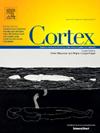Bidirectional and asymmetric smooth pursuit deficits in childhood hemispherectomy patients
IF 3.3
2区 心理学
Q1 BEHAVIORAL SCIENCES
引用次数: 0
Abstract
The neural circuitry engaged in supporting eye movements has been well characterized, but fundamental questions remain about the necessity and sufficiency of the individual hemispheric contributions. To gain a better understanding of the neural correlates of oculomotor control, we measured horizontal smooth pursuit tracking behavior in 14 patients following childhood hemispherectomy. Relative to developmentally typical age-matched controls, patients exhibited a bilateral and asymmetric pursuit deficit with reduced ipsilesional but elevated contralesional eye speeds, and asymmetric accompanying ‘catch up’ saccades. The atypical pursuit behavior could not be explained by a sensory deficit associated with their hemianopia, as patients adjusted their eye position to maintain visibility of the target. The pursuit deficit was also not accounted for by a general motor impairment as patients made faster catch-up saccades than controls, particularly in the ipsilesional direction. These results, all of which hold irrespective of whether the right or left hemisphere is resected, demonstrate that patients can compensate for reduced pursuit speeds by modulating their saccade characteristics. Overall, this study represents the most comprehensive characterization of smooth pursuit disturbances in hemispherectomy patients. Our results elucidate: 1) the competence of a single hemisphere for generating pursuit and compensatory behaviors; 2) the lack of a hemispheric bias supporting pursuit given large-scale cortical disruptions; and 3) that intact horizontal pursuit likely requires the interaction of brain circuitry across both hemispheres.
儿童半球切除术患者的双向和不对称平滑追求缺陷
参与支持眼球运动的神经回路已经被很好地描述了,但是关于单个半球贡献的必要性和充分性的基本问题仍然存在。为了更好地了解动眼肌控制的神经相关性,我们测量了14名儿童半球切除术后患者的水平平滑追求跟踪行为。与发育典型的年龄匹配对照组相比,患者表现出双侧和不对称的追求缺陷,同侧眼速降低,但对侧眼速升高,不对称伴有“追赶”扫视。这种非典型的追求行为不能用与偏视相关的感觉缺陷来解释,因为患者会调整眼睛的位置以保持对目标的可见性。一般运动障碍也不能解释追逐缺陷,因为患者的追赶扫视速度比对照组快,尤其是在同侧方向。这些结果,无论左半球还是右半球被切除,都证明患者可以通过调节他们的扫视特征来补偿追逐速度的降低。总的来说,这项研究代表了半球切除术患者平滑追求障碍的最全面的特征。我们的研究结果表明:1)一个半球的能力产生追求和补偿行为;2)在大范围皮层破坏的情况下,缺乏支持追逐的半球偏倚;3)完整的水平追逐可能需要两个半球大脑回路的相互作用。
本文章由计算机程序翻译,如有差异,请以英文原文为准。
求助全文
约1分钟内获得全文
求助全文
来源期刊

Cortex
医学-行为科学
CiteScore
7.00
自引率
5.60%
发文量
250
审稿时长
74 days
期刊介绍:
CORTEX is an international journal devoted to the study of cognition and of the relationship between the nervous system and mental processes, particularly as these are reflected in the behaviour of patients with acquired brain lesions, normal volunteers, children with typical and atypical development, and in the activation of brain regions and systems as recorded by functional neuroimaging techniques. It was founded in 1964 by Ennio De Renzi.
 求助内容:
求助内容: 应助结果提醒方式:
应助结果提醒方式:


